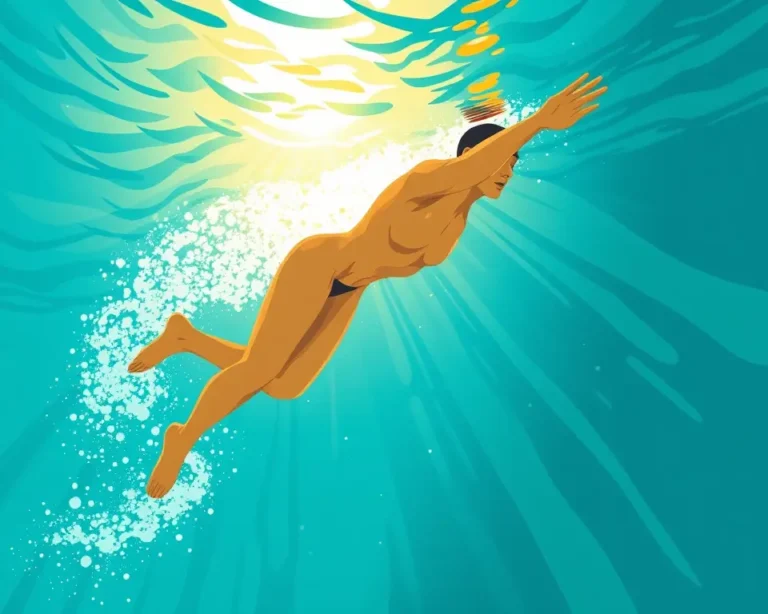Swimming offers a refreshing alternative to traditional workouts, providing a full-body exercise with minimal impact. Whether you’re a seasoned athlete or just starting your fitness journey, incorporating swimming into your routine can yield significant physical and mental benefits.
The Allure of Aquatic Fitness
Swimming engages nearly every muscle group in your body, increasing muscle strength and cardiovascular fitness. The water’s resistance provides a natural form of resistance training, enhancing endurance and toning muscles. Unlike high-impact activities like running, swimming is gentle on the joints, making it an ideal choice for individuals with joint pain, muscle strain, or those recovering from injuries.
Benefits Beyond the Physical
Beyond the physical advantages, swimming offers a unique mental escape. The rhythmic strokes and the sensation of weightlessness can reduce stress and promote relaxation. Studies have shown that swimming can improve mood, reduce anxiety, and enhance cognitive function. It is also an activity that can be performed across the age and ability spectrum.
Getting Started: Making a Splash
Ready to jump in? Here’s how to seamlessly integrate swimming into your fitness regimen:
Setting Achievable Goals
Before diving in, define your objectives. Are you aiming to improve cardiovascular endurance, build muscle, increase flexibility, or simply diversify your workout? Clear goals will guide the frequency, duration, and intensity of your swimming sessions. Remember to set realistic expectations, especially if you’re new to lap swimming.
Building a Sustainable Schedule
Consistency is key. Begin with 1-2 swimming sessions per week, allowing your body to adapt. Gradually increase the frequency to 3-4 times a week, balancing it with other activities you enjoy. Consider the availability of lap lanes at your local pool and adjust your schedule accordingly.
Structuring Your Swim Workout
A well-rounded swim workout mirrors other fitness routines, comprising a warm-up, main set, and cool-down:
- Warm-up: Swim for 5-10 minutes at a relaxed pace, focusing on stretching and acclimatizing to the water.
- Main Set: Incorporate intervals, such as swimming 2-4 laps with short breaks. Gradually increase the lap count or reduce rest time as your endurance improves. Experiment with different strokes to target various muscle groups.
- Cool-down: Conclude with 5 minutes of easy swimming to lower your heart rate.
Sample Beginner Swim Workouts
Here are a couple of sample beginner swim workouts that you can try:
Workout 1
- Warm-up: 400 meters freestyle at an easy pace
- Main set: 4 x 50 meters freestyle with 20 seconds rest, 4 x 25 kick with 20 seconds rest
- Cool-down: 8 x 25 swim with perfect technique with 30 seconds rest
- Total distance: 900 meters
Workout 2
- Warm-up: 200 meters alternating freestyle and backstroke
- Main set: 10 x 50 swim at 80% effort, alternate freestyle and non-freestyle stroke, with 25 seconds rest
- Cool-down: 100 swim easy
- Total distance: 800 meters
Mastering the Strokes: A Guide to Swimming Styles
Different strokes engage different muscle groups, adding variety and maximizing your workout.
Freestyle (Front Crawl)
The most common stroke, freestyle, is excellent for overall conditioning. It involves alternating arm movements with a flutter kick, engaging your core, back, and shoulder muscles.
Backstroke
Performed on your back, this stroke targets your back and shoulder muscles. It requires a coordinated alternating arm motion with a flutter kick, promoting spinal mobility.
Breaststroke
The breaststroke engages your chest, triceps, and inner thigh muscles. It involves a simultaneous arm movement with a “frog-kick,” requiring precise timing and coordination.
Butterfly
The butterfly is the most demanding stroke, working your core, upper body, and legs. It involves a simultaneous arm motion with a dolphin kick, requiring significant strength and coordination.
Individual Medley (IM)
The IM combines all four strokes in a specific order: butterfly, backstroke, breaststroke, and freestyle. It provides a comprehensive full-body workout, challenging your strength, endurance, and coordination.
Equipment Essentials
While swimming requires minimal equipment, a few essentials can enhance your experience:
- Swimsuit: Choose a comfortable, well-fitting swimsuit that allows for a full range of motion.
- Goggles: Protect your eyes from chlorine and improve visibility underwater.
- Swim Cap: Reduce drag and protect your hair from chlorine damage.
- Kickboard: Isolate your leg muscles for targeted training.
- Pull Buoy: Focus on your upper body strength by immobilizing your legs.
- Fins: Increase propulsion and improve your kick technique.
Safety First: Prioritizing Well-being
Before embarking on your swimming journey, consider these safety precautions:
- Consult Your Doctor: If you have any underlying health conditions, consult your doctor before starting a new exercise program.
- Swim in Designated Areas: Always swim in designated swimming areas with lifeguard supervision.
- Never Swim Alone: Avoid swimming alone, especially in open water.
- Learn Basic Water Safety Skills: Familiarize yourself with basic water safety skills, such as floating and treading water.
- Stay Hydrated: Drink plenty of water before, during, and after your swim.
- Listen to Your Body: Stop if you feel pain, dizziness, or fatigue.
Beyond the Pool: Cross-Training Benefits
Swimming complements other forms of exercise, providing a low-impact alternative for active recovery or cross-training. It can enhance your performance in other sports by improving cardiovascular fitness, muscle strength, and flexibility.
Combining Swimming with Weightlifting
Swimming can be combined with strength training to build muscle. The resistance of the water provides a form of resistance training similar to lifting weights.
Making Swimming a Lifelong Habit
Integrating swimming into your fitness routine is an investment in your long-term health and well-being. By setting realistic goals, structuring your workouts, and prioritizing safety, you can make swimming a sustainable and enjoyable part of your lifestyle. So, grab your swimsuit, dive in, and experience the transformative power of aquatic fitness.







